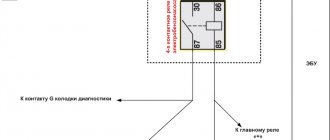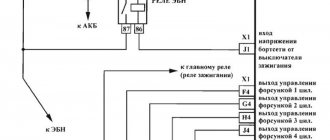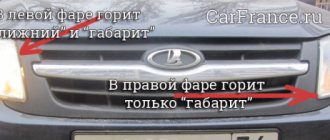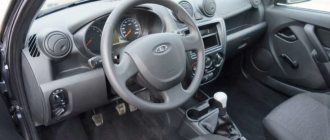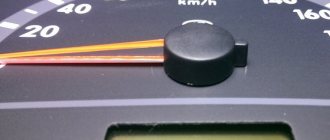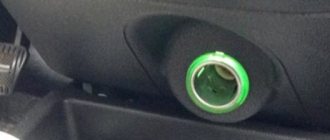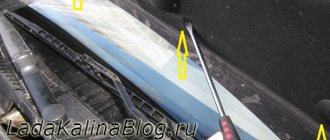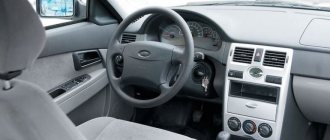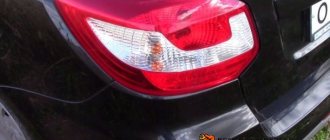Signs and causes of malfunctioning turn signals and emergency signals
These elements of the lighting system stop working due to:
- Blown fuse box in the passenger compartment. This problem occurs often. If the car is equipped with a relay that regulates the operation of lighting devices, the cause should be looked for in it. Depending on the make of the car, this part may be located at different distances from the fuses. The diagram attached to the instructions helps you find it.
- Short circuits in the on-board network. Because of this, the turn lights do not light up and the hazard warning lights go off instead. The system stops responding to user commands. To detect a breakdown, you will need a multimeter. The driver must understand the electrical circuit.
- Failure of the lighting source. In this case, replace the burnt out light bulb.
- Broken wiring. This is what owners of outdated VAZ car models face. If the wires are laid in places where there are moving parts, the braid will fray over time. The integrity of the electrical circuit section is compromised.
- Failure of the turning light control element or steering column switch. In this case, a thorough diagnosis of the control buttons is required.
The following signs help determine the presence of malfunctions in the optical system of the machine:
- The turn signals are on continuously. The symptom appears when the relay breaks down, in particular its electromagnetic component. It often gets stuck in one position, causing it to be unable to return to its original position.
- The blinking frequency of the turning lights has changed. The source of this malfunction is not only the relay, but also the wrong type of light bulb. When purchasing new lighting products, take into account the value declared by the car manufacturer.
- The optical system is not functioning. Not only the lights do not light up, but also the indicators on the center console. The clicks that occur when the indicators are turned on are not observed. There are many reasons for such malfunctions.
Turn signals don't work
The most common cause of turn signal failure is failure of the lamps themselves. In this case, the resistance of the circuit decreases, as a result of which the frequency of operation of the relay is sharply reduced - this can be noticed immediately after the lamp fails. What to do if this happens while driving:
- Find a place to stop so as not to interfere with traffic
- Turn on the turn signal and see which of the three lamps has failed
- Unscrew the light bulb and check the integrity of the filament
- Replace the lamp if necessary. The lamps are sold in every store and are universal for almost all cars - be it a VAZ or a foreign car.
If the entire turning side does not work, then you need to look for a fault among the fuses, relays and wiring. If you are not at all versed in electrics, we recommend learning the basics by looking at articles, photos and videos about using a multimeter.
Fuses and relays in Lada Granta, electrical diagrams
If you bought a Granta and started having electrical problems, you may be faced with a manufacturing defect. But don’t be alarmed ahead of time, the first thing you need to do is check the fuses and relays in the Lada Granta and find out the cause of the malfunction. If you're lucky, you'll get away with simply replacing the fuse.
If not, you may have to go to a car service center or troubleshoot the electronics yourself. Remember - the main thing in such cases is to fully understand the problem, do not waste time on this, because any car owner should know as much as possible about his car (especially a domestic one).
Where is the grant turn relay located?
The product is located in a special mounting block of the dashboard. The block contains many fuses and relays that are responsible for the operation of various electrical consumers. The block is protected by a special plastic cover and is located in the left, lower part of the panel, next to the headlight switch. Marking of the turn signal relay on the Grant K5
Read also: 2107 On tori r17
Causes of direction indicator malfunctions
- Failure of the steering column switch.
- Damage to the turn signal relay.
- The hazard warning button is faulty.
- Open circuit. If the turn signals do not work on all sides, the first thing to check is the turn signal relay power wires. If the indicators stop working on only one side, the problem is in the wires running from the steering column switch to the light bulbs.
- Oxidized contacts, broken wires. The turn signals do not work if the circuit resistance differs significantly from the nominal value. To supply power, it is necessary to exceed a certain power level of consumers. If the microcircuit inside the turn signal relay does not register sufficient current due to increased resistance, power will not be supplied to the bulbs.
Device
The following are involved in the operation of turn signals:
- steering column turn switch. Its function is to close the power contact of the light bulbs. For example, when you turn the switch up, one of the contacts of the light bulbs on the right side closes to the “+” of the battery. The “minus” of the light bulb is the connection point to “ground” (the common point for all headlight bulbs);
- turn signal relay. There is a regular electromagnetic relay inside the case, but it is controlled by a microcircuit. It is thanks to this element that an intermittent power supply to the coil is ensured. The second important function is monitoring the health of the lamps. The microcircuit has a feedback function, so when a light bulb burns out, it registers a decrease in the power of consumers and begins to supply power to the coil at double the frequency. If the turn signals are working properly, the lights blink approximately once per second. Most modern cars, including VAZ models, use a 3-pin turn signal relay. Accordingly, 1 contact is “ground”, 2 – power supply from the battery, 3 – output to the steering column switch;
- light indication on the dashboard. One or two light bulbs (one on each side) are connected in parallel to the electrical circuit of the main lamps. The turn signals will work without a light indication, so the system should not be considered among the possible causes of the malfunction.
Lada Kalina. Direction indicators
Until today, I have not encountered this problem on the Lada Kalina and Lada Granta at all, and have not even heard of such a problem. LADA Kalina (Lada-Kalina) is a family of Russian cars of group II small class. Produced by AvtoVAZ OJSC since November 18, 2004. The first generation of Lada Kalina was produced until March 1, 2013. The development of the car was started by AvtoVAZ in 1993. In 1998, the designed car was named “Lada-Kalina”.
However, today I had to deal with just such a problem, namely: one side of the turns (in my case, the left one) does not go out at all. Just “on-not blinking-constantly”, even with the ignition off. There is no alarm on the car and there was never one. It goes out only when the battery is disconnected. The right side, when turning on the steering column switch to turn right, responded to this command one time out of ten. The hazard warning lights sometimes also turned on, but only when the ignition was on. Since this car does not have a turn relay as such in principle, and AVTOVAZ entrusted its functions to the VSM (or TsBKE - Central Block of Body Electrics, we can say so, the essence is the same), I hook up the scanner and receive an irremovable error in the electrical package stating that there is a short circuit in the left side turning circuit. I switch the scanner to current data mode - it shows that the CBKE perfectly understands that I am trying to turn on the right or left turn or the hazard warning lights (the corresponding positions change their status from OFF to ON) - but cannot respond to my commands. Most likely, the problem is in the CBKE itself. This means that we need to try to repair this miracle of Russian electronics from NPO Itelma, because in stores in our city this device is only available on order, and it costs about 7 thousand rubles. All that remains is to remove it from the car, although in this case the word “uproot” is more applicable.
Now, what I would like to say to the “developers” of Granta and Kalina-2... Not only is the mounting block in the cabin made integral with the under-panel wiring (without connectors), and it can only be moved a little to the side, but they also “screwed” the VSM over it’s on top, and you can’t get underneath it because of the bunch of connectors fastened to the welded frame of the front panel... and to remove the VSM, you first need to break your arm in at least two places!
Headlights
Everyone remembers that driving with faulty lighting devices is prohibited. However, if a partial malfunction occurs, many simply continue driving, hoping that the remaining light will be enough for them. This is a dangerous practice that, in addition to a hefty fine, can cause a serious accident, especially in bad weather.
At this point we are not even talking about the complete loss of functionality of one of the headlights, but, for example, about the gradual loss of transparency of lenses or diffusers, untimely adjustment of the light flux, as well as banal pollution.
Always check the functionality of the lighting devices, especially if you are traveling in the dark or in bad weather, carry out all routine maintenance in accordance with the recommendations, and also if there are only the slightest changes in their operating parameters. Even if it’s snowing or raining, wipe your headlights - this will significantly improve the road illumination for at least a few kilometers of your route.
Why does the turn signal flash three times?
Many car enthusiasts are surprised by the function of car turn signals, thanks to which they always blink three times. It has been around for many years, but not many people know why a triple signal is needed and what its meaning is, which is worth talking about in more detail.
From single to triple. Automakers began using triple turn signals in the early 2000s. The process happened gradually; German models were the first to receive this function, followed by all the others. In 2010, it was already possible to see a new function on Russian cars, and a few years ago the UAZ plant began using similar technology for emergency lights.
When you press the signal, the driver will see a double light, which has already been nicknamed the “polite driver” among motorists.
Why triple signal? The triple signal began to be used because it is convenient to use it when changing lanes, when the movement is almost straight, and automatic switching off of the signal does not work, since the steering wheel does not deviate much to the side. Then the motorist would have to press the “flashing lights” several times, which becomes distracting while driving.
Empirically, during testing, experts came to the conclusion that a triple signal in this situation will be more effective in ensuring that road users see the intentions of the vehicle owner and he can change lanes without problems.
Convenient feature. It is noteworthy that the mandatory use of a triple signal is not stated anywhere, however, due to convenience, most motorists decided to use it. Despite the shortcomings, for example, on LADA models there is only such an opportunity to warn other drivers, but in foreign cars and crossovers there is a function for connecting an on-board computer that regulates the duration of the signal, it is implemented in many situations.
It is noteworthy that modern car models even have a function for selecting the number of signals - from one to five. Some vehicle owners even change the relay settings, but interfering with the factory algorithm does not cause any harm to the car.
Bottom line. Not many drivers know why the turn signal light always flashes three times. It would seem that this function comes naturally in all cars, but this is not the case. Initially, only one light signal was used, but later there were three, and in modern cars five.
This solution allows motorists to quickly find their bearings and change lanes when driving on the road, which clearly confirms the use of technology in all models and the approval of motorists.
Rain is a joy for us. Test drive of Viatti Bosco H/T V-238 SUV tires
See all photo news >>
Self-diagnosis of car lighting devices
There are several situations in which you can determine that optics need diagnostics:
- The turns do not flash, but light up. Such a malfunction indicates the failure of the relay, in particular, we are talking about its electromagnetic component. The electromagnet itself could close in one of the positions, as a result of which it cannot return to its initial state.
- The turning lights flash very quickly or very slowly. In this case, the problem may lie not only in the relay. In some cases, this type of malfunction occurs when the driver uses inappropriate lighting sources. So when purchasing new light bulbs, you need to make sure that they correspond to the rating set by the car manufacturer.
- The optics don't work at all. That is, the turning light bulbs do not flicker, and the corresponding indicators on the dashboard also do not light up. In addition, there are no characteristic clicks that appear when turning on the turning lights. With such symptoms, there can be many reasons for the problem; we will tell you more about their diagnosis below (the author of the video is the Steel Horse channel).
As for diagnostics, it is performed in several stages:
- First of all, you need to make sure that all sensors and indicators on the device are working. If they do not function, then it is necessary to diagnose the safety devices.
- If all devices are operating in normal mode, then you next need to turn on the light alarm button and diagnose all light sources in the headlights. That is, check the front, rear, and side (if any) lights.
- If the alarm does not function when activated, you need to check the functionality of the relay, and also check the power supply at the terminals. To do this, remove the relay from its mounting location, and then, using a test light, connect one of its contacts to the installation site (to the positive), and the other to the car body or battery. There is no need to turn on the ignition. If there is no power, then most likely the reason lies in a failed safety device, a broken hazard warning button, or a damaged electrical circuit. Also, the essence of the problem may lie in poor contact in the connecting plugs.
- If there is a plus on the contacts, then try shorting the two relay terminals using copper wiring. If all electrical circuits, as well as the connection plugs, are working properly, then all turn signals should light up. In this case, the fault must be looked for in the relay.
- If the lights do not light up after the steps you have performed, then most likely the cause of the malfunction lies in the emergency light control button. However, in practice this happens quite rarely; there is often a short circuit in the circuit. By the way, it is a short circuit that can lead to a breakdown of the relay, therefore, before replacing the failed element, you need to eliminate the short circuit.
- If the emergency signal is functioning, this indicates that the safety devices and relays are working; accordingly, you need to start diagnosing the button itself. First of all, you need to diagnose the positive terminal, as in the case of checking the relay, while the ignition, as well as the hazard warning button, must be activated. If the diagnostics showed that there is no plus, this indicates that the button itself needs to be checked in more detail. Remove it from its seat and check the connection circuit. If there is no power, then you need to look for a break in the wiring from the tidy to the button itself. If there is power, then you will need to short-circuit the terminals at the installation site, the ignition does not turn off, after which you need to activate the direction indicators (on either side). When the lighting sources are turned on, the control button must be replaced, but if there is no power, then you need to check the power in the emergency relay. If there is no power, the problem most likely lies in a break in the connecting electrical circuit from the control key to the block with safety devices.
Video about the reasons why turn signals do not work on Kalina
During the operation of the car, the driver encounters various malfunctions. In certain cases, it is recommended to contact a service center to eliminate them; in others, for example, you can deal with the breakdown of the emergency lights and turn signals of the Lada Kalina 2 yourself.
Procedure in case of malfunction of the direction indicators:
- Check to see if the turn signal lamps are burnt out.
- Check the “ground” and “power” on the turn signal connector using a multimeter or a +12V test lamp.
- Check the operation of the emergency stop button and clean the contacts.
- Check the integrity of the wiring using the Lada Kalina 2 electrical diagrams.
- The Lada Kalina 2 mounting block does not have a relay or fuse for turn signals; the central body electronics unit (CBEC) is responsible for its operation. To check it, you should contact the service.
Let us remind you that the website has other instructions for operating and repairing the Lada Kalina 2.
Key words: turn signals Lada Kalina
If one or another electrical device in your Kalina has stopped working - headlights, low or high beams, cigarette lighter, stove, turn signals, as well as other devices, then the first thing you need to do is find the cause of the malfunction, in particular, check the fuses and relays in the Lada Kalina.
The first thing to check in electrical circuits is the fuses, because they are the weakest point of the circuit and are usually the first to fail. Read on to learn about which fuses do what in the Lada Kalina, as well as where the relays are located and how to find the right one.
If you do not want to get into an unpleasant situation when, due to a blown fuse, one or another device refuses to work, but you don’t have a whole one at hand, it is useful to make it a rule to always carry with you a set consisting of different fuses.
For the Lada Kalina, you can buy a similar set at any auto store that sells auto parts for domestic cars. It takes up very little space, but its benefits in case of failure will significantly reduce your time to fix the problem.
Relay and fuse box
The fuses in the Lada Kalina are located under the dashboard, in a block located to the left of the steering wheel. To get to it, you need to open the cover in which the headlight switch is built in. The lid has latches; if you pull it towards you by the upper part, it will open and fold down (its lower part is fixed on an axis).
F1 (10 A) - immobilizer, dashboard lamps and sensors, reversing light, turn signals.
- If any of the gauges on your dashboard stop working, or one or all of the warning lights stop lighting up, check that fuse, as well as the gauges or bulbs themselves.
- If the rear white light does not come on when you engage reverse gear, it could also be this fuse or the reverse switch.
- The reverse switch is located on the transmission, to change it you will most likely need to remove the engine cover to get to it. Located on the left side in the direction of travel on the rear of the gearbox.
- If the turn signals do not work and this fuse is intact, also check relay K5, the turn signal control knob, its connector, as well as the turn signal lamps themselves.
F2 (30 A) - electric windows.
- If the power windows stop working, check this fuse, as well as relay K2.
- If the fuse and relay are good, there could be a number of reasons. First, try pressing the power window button and slamming the door.
- If the mechanism “bites” when the glass is raised, this may help.
- Otherwise, you need to disassemble the casing and look at the mechanism. When disassembling, you need to check the serviceability of the gears and all components of the window lifter, including the motor brushes.
- It could also be a problem with the power window module. It is located in the left rear door; if there is something wrong with it, then most likely you will have to change this module to a working one.
F3 (10 A) - alarm.
- If the emergency lights do not work and this fuse is good, check relay K5.
- If your left or right turn signals come on and are constantly on, even when you turn off the ignition, this is a factory defect. In this case, it is necessary to replace the body electronics control unit. This can be done in official salons.
F4 (20 A) - windshield wiper, heated rear window.
- If the windshield wipers do not work and this fuse is intact, also check relays K4 and K6.
- The issue may be in the windshield wiper motor or its mechanism. Check the wiper switch and its connector.
- If the rear window heating does not work, check fuse F8, the heater terminals, their contacts, as well as the contacts of this fuse and relay K6.
- Another issue could be poor contact on the body. The wiring ground is connected to the body under the dashboard. If there is poor or oxidized contact in this area, it can also cause problems with the correct readings on the panel instruments.
Fuses and relays in Lada Kalina, electrical diagrams
Fuses and relays in Lada Kalina, electrical diagrams
If one or another electrical device in your Kalina has stopped working - headlights, low or high beams, cigarette lighter, stove, turn signals, as well as other devices, then the first thing you need to do is find the cause of the malfunction, in particular, check the fuses and relays in the Lada Kalina.
The first thing to check in electrical circuits is the fuses, because they are the weakest point of the circuit and are usually the first to fail. Read on to learn about which fuses do what in the Lada Kalina, as well as where the relays are located and how to find the right one.
If you do not want to get into an unpleasant situation when, due to a blown fuse, one or another device refuses to work, but you don’t have a whole one at hand, it is useful to make it a rule to always carry with you a set consisting of different fuses.
For the Lada Kalina, you can buy a similar set at any auto store that sells auto parts for domestic cars. It takes up very little space, but its benefits in case of failure will significantly reduce your time to fix the problem.
Relay and fuse box
The fuses in the Lada Kalina are located under the dashboard, in a block located to the left of the steering wheel. To get to it, you need to open the cover in which the headlight switch is built in. The lid has latches; if you pull it towards you by the upper part, it will open and fold down (its lower part is fixed on an axis).
F1 (10 A) - immobilizer, dashboard lamps and sensors, reversing light, turn signals. If any of the gauges on your dashboard stop working, or one or all of the warning lights stop lighting up, check that fuse, as well as the gauges or bulbs themselves. If the rear white light does not come on when you engage reverse gear, it could also be this fuse or the reverse switch.
The reverse switch is located on the transmission, to change it you will most likely need to remove the engine cover to get to it. Located on the left side in the direction of travel on the rear of the gearbox.
If the turn signals do not work and this fuse is intact, also check relay K5, the turn signal control knob, its connector, as well as the turn signal lamps themselves.
F2 (30 A) - electric windows. If the power windows stop working, check this fuse, as well as relay K2. If the fuse and relay are good, there could be a number of reasons. First, try pressing the power window button and slamming the door. If the mechanism “bites” when the glass is raised, this may help.
Otherwise, you need to disassemble the casing and look at the mechanism. When disassembling, you need to check the serviceability of the gears and all components of the window lifter, including the motor brushes. It could also be a problem with the power window module. It is located in the left rear door; if there is something wrong with it, then most likely you will have to change this module to a working one.
F3 (10 A) - alarm.
If the emergency lights do not work and this fuse is good, check relay K5.
If your left or right turn signals come on and are constantly on, even when you turn off the ignition, this is a factory defect. In this case, it is necessary to replace the body electronics control unit. This can be done in official salons.
F4 (20 A) - windshield wiper, heated rear window. If the windshield wipers do not work and this fuse is intact, also check relays K4 and K6. The issue may be in the windshield wiper motor or its mechanism. Check the wiper switch and its connector.
If the rear window heating does not work, check fuse F8, the heater terminals, their contacts, as well as the contacts of this fuse and relay K6. Another issue could be poor contact on the body. The wiring ground is connected to the body under the dashboard. If there is poor or oxidized contact in this area, it can also cause problems with the correct readings on the panel instruments.
F5 (25 A) - heater, electric power steering, windshield washer. If this fuse and relay K4 are intact and the stove does not work, the problem may be in its electric motor (brushes) or the power button, as well as its contacts. If the electric power steering does not work, this fuse and fuse F31 are intact, then it is better to contact a workshop, because it will be difficult to find and fix this malfunction yourself.
F6 (20 A) - sound signal.
If this fuse and relay K8 are working, but the signal does not work, check the horn itself. It is located under the front bumper near the radiator. Sometimes it is enough to turn the adjustment screw
vmiredorog.ru
Replacing the Lada Granta Turn Signal Relay – Driver tips and reviews
What to do if the turn signals on the Lada Granta do not work
It happens: the Lada Granta made you happy and happy, and then take the turn signals and leave them. And what’s scary in this situation is not the fine, but the danger that arises when changing lanes and turning. Of course, you can also give signals with your hand, but it is much more convenient to use turn signals. Perhaps you have to replace the Lada Granta turn signal relay, maybe you have to replace the lamps. You need to understand everything in detail.
Changing the lamp
So, we have the following task: Lada Granta turn signals do not work. The first step is to check whether the lamp has burned out. Let's say it burned out. This means it needs to be replaced. The front turn signals are equipped with PY21W lamps; you can purchase a new lamp and replace it yourself.
In order to pull out the lamp, you need to press on the socket and turn it. The direction of rotation depends on which side the headlight is located on. If on the right, then turn it clockwise. On the left - against, of course. Next, it should be pulled out of the cartridge. To do this, press the lamp and turn it counterclockwise all the way. Now you can insert a new lamp and return everything as it was.
A W5W lamp is installed in the side turn signal. How to get it? Let's say you are on the right wing. In this case, you need to move the turn signal housing to the right (correspondingly, the left one - to the left) and remove the indicator. The lamp socket rotates counterclockwise. Having taken out the lamp, you can replace it and put everything back together, after inspecting the rubber gasket. If you are not satisfied with it, this is a good time to replace it.
Relay block for VAZ - Lada Granta
This video shows where the relay block is located on a VAZ Lada Granta, and also shows how and where to find the right one...
https://youtube.com/watch?v=7ClGDs5zPeM
Turn signals and emergency lights do not work on Grant//relay replacement
Are the relays clicking? Then watch carefully, I’ll tell you how to get rid of it in literally 10 minutes. Well, as a...
Everything is fine with the lamp, but the turn signals on Grant still don’t work? Let's move on.
Checking the serviceability of the fuse
This is the next stage of action when the turn signals of the Lada Grant do not work. Now open the mounting block. It is located on the left side of the dashboard. There you will find 32 fuses. For standard cars, the fuse we need is marked F6, which also serves the reversing light.
A malfunction is determined by a burnt-out hair, but it is not always possible to confine yourself to just a visual inspection. Therefore, you need to replace it with a new one. If the old one was faulty, then it is necessary to check the entire circuit (after all, it didn’t just burn out). To do this, you will need a multimeter or a test lamp. For example, the right turn signal of the Lada Granta does not work. You need to ring all the bulbs in this circuit and find a short circuit. The next step is Lada Granta turn signal relay.
Checking the relay
Where is the Grant turn signal relay located? Everything is in the same mounting block. Marking K5.
How to replace the turn signal relay on a Lada Grant? It can be removed using a puller located in the mounting box, and then a known-good unit can be placed in the free space. If everything works with the new relay, then the problem is solved. However, even before searching for a burnt-out lamp, you can check the Lada Granta turn signal relay.
If you are faced with the fact that the turn signals on your Grant are constantly on, then this probably indicates that something is shorting somewhere. You need to test the circuit with a multimeter. Sometimes in this case it is possible to establish the influence of emergency lights and even signaling. Remember if you changed anything there before the problems with the turn signals appeared.
Another common problem is the situation when the turn signals on a Lada Granta do not work, but the emergency lights do work. It is necessary to check whether everything is in order with the emergency button. It happens that the button simply moves away. It needs to be given a normal position, and the turn signals will work.
A separate story is the problems with cars of this design. When the turn signal on a Grant Lux does not work, the problem may be with the microcircuit located in the TsBKE unit. It does not have a voltage reserve, which leads to the question: “Why do the turn signals on Grant constantly light up.” Here's why: there was a short circuit there. The problem is solved by replacing the CBKE. By the way, this unit is located in the cabin, under the front panel.
Replacing the turn relay on Grant
First of all, we find and remove the protective cover of the fuse box (mounting block). To do this, you need to snap off the special latches. It is best to start the removal process from the upper left corner. Pick up the corner of the cover, apply force and remove the fastening clamp from the groove. Pull the decorative element towards you. After all the latches have come out of the grooves, do not make sudden movements or yank the body of the decorative cover. The thing is that there is a trunk opening button on the body, to which a contact chip with wires is attached. Therefore, in order not to damage the contacts and carry out further work, the chip must be disconnected from the button connector. After dismantling the decorative cover, we get free access to the mounting block with fuses and relays
Please note that a special plastic puller is provided for removing fuses, which greatly facilitates the entire process of work. To remove the relay, the mounting block contains the same puller, only of a larger size.
In addition, on the back (inner) side of the decorative cover there is a diagram with detailed identification of all internal components, which is very convenient when working. All elements in the mounting block have their own markings. The product called “K5” is responsible for the operation of turn signals and hazard warning lights. The relays in the block are installed quite reliably and in order to replace them you will need to use some physical force. It is best to dismantle the part using a puller. However, quite often, it is not possible to remove the relay even when using it. The ideal solution for such cases is to use pliers. Reinstalling the cover is a little more complicated than removing it. Don't forget to connect the contact chip to the connector of the rear trunk release button. We recommend starting installation from the bottom right side. Place the rightmost latch into the hole, then do the same with the central and leftmost latch. After that, move to the upper fasteners and carry out similar manipulations. With a simple push, snap the decorative cover onto the panel. This completes the removal and installation process.
https://youtube.com/watch?v=eSW_JQyzuuc
"Important. If the relays in your car are constantly failing, then there is reason to conduct a thorough diagnosis of the corresponding power supply circuit.”
Turn relay LADA GRANT, where is the replacement located
It happens that during the operation of the car minor breakdowns occur in the form of failed electrical equipment. Failure of the instrument panel lights or hazard lights is not so bad. But what if the turn signals fail?
In conditions of increased traffic density on city roads, failure of the turning system is fraught with emergency situations for motorists. Therefore, the issue of maintaining electrical equipment in good technical condition is very important.
The causes of turn signal malfunctions may be:
- broken light bulbs in signs;
- blown fuse;
- faulty turn signal relay.
In each specific case, it is necessary to conduct a thorough diagnosis of possible problems.
Where is the grant turn relay located?
The product is located in a special mounting block of the dashboard. The block contains many fuses and relays that are responsible for the operation of various electrical consumers. The block is protected by a special plastic cover and is located in the left, lower part of the panel, next to the headlight switch. Marking of the turn signal relay on the Grant K5
Grant turn signal relay diagram
The general diagram of the mounting block is not particularly complicated and is conventionally divided into 3 areas: - a block with fuses; - an area with installed relays; - an area with working devices and a fuse responsible for the operation of the heater.
Fuses differ in current strength measured in Amperes. Their markings begin with "F1" and end with "F32". Accordingly, a total of 32 fuses are installed in the module. Rated current varies from 2 amperes to 30.
Relays have designations from “K1” to “K12” and differ in their size and functional purpose.
Replacing the turn relay on Grant
- First of all, we find and remove the protective cover of the fuse box (mounting block). To do this, you need to snap off the special latches. It is best to start the removal process from the upper left corner. Pick up the corner of the cover, apply force and remove the fastening clamp from the groove. Pull the decorative element towards you.
- After all the latches have come out of the grooves, do not make sudden movements or yank the body of the decorative cover. The thing is that there is a trunk opening button on the body, to which a contact chip with wires is attached. Therefore, in order not to damage the contacts and carry out further work, the chip must be disconnected from the button connector.
After dismantling the decorative cover, we get free access to the mounting block with fuses and relays. Please note that a special plastic puller is provided for removing fuses, which greatly facilitates the entire process of work. To remove the relay, the mounting block contains the same puller, only of a larger size. In addition, on the back (inner) side of the decorative cover there is a diagram with detailed identification of all internal components, which is very convenient when working. All elements in the mounting block have their own markings. The product called “K5” is responsible for the operation of turn signals and hazard warning lights. The relays in the block are installed quite reliably and in order to replace them you will need to use some physical force. It is best to dismantle the part using a puller. However, quite often, it is not possible to remove the relay even when using it. The ideal solution for such cases is to use pliers. Reinstalling the cover is a little more complicated than removing it. Don't forget to connect the contact chip to the connector of the rear trunk release button. We recommend starting installation from the bottom right side. Place the rightmost latch into the hole, then do the same with the central and leftmost latch. After that, move to the upper fasteners and carry out similar manipulations. With a simple push, snap the decorative cover onto the panel. This completes the removal and installation process.
https://youtube.com/watch?v=eSW_JQyzuuc
"Important. If the relays in your car are constantly failing, then there is reason to conduct a thorough diagnosis of the corresponding power supply circuit.”
Typical turn signal malfunctions and their elimination
So, for what reasons do the turn signals not light up? Why does the high beam turn on when I turn on the turn signal? What does a frequently flashing light indicate and why can contacts in an electrical circuit short out? The main reasons why turn signals do not work, as well as solutions, are given below.
Car steering switch with emergency lights
Doesn't blink
When the turn signals do not blink when turned on, most likely the essence of the malfunction lies in the breakdown or burnout of the corresponding relay installed in the mounting block. If, when activating the optics, you notice that it can no longer light, then the reason may be a short circuit caused by moisture, or interruption of contact. In this case, it is better to change the contact itself
If replacing the relay does not help solve the problem, pay attention to the integrity of the safety element. When the turn signals are constantly on and the safety element is working, you should check the light button, as well as the steering switch
Activating high beams instead of turning
If the high beam turns on when you turn it on, then in this case we can say with confidence that the problem lies in the steering column switch. The contacts in it could be closed, as a result of which, when the angle of the switch position changes, the wrong thing is turned on. As a rule, such a malfunction can be solved by resoldering the contacts or replacing the switch.
Activating the steering switch
Doesn't turn on
If the optics do not work in principle, there may be several reasons.
What could be the problem and how to get the lights back to working properly:
- The light bulb itself has failed, in which case it can be replaced.
- Missing or poor contact. It is necessary to diagnose the contacts on the headlight itself, the steering column switch, and also in the fuse box.
- Failure of the light alarm button.
- The safety element or relay has failed. It is also necessary to diagnose the contacts of these components.
Doesn't turn off
Many modern car enthusiasts face the problem when the optics do not turn on at all. As a rule, in this case the reason is a faulty switch; it just needs to be changed (the author of the video is the New Jersey TV channel).
Blinks quickly
If the turning optics blinks frequently, much more often than usual, then first you should diagnose the so-called chip located on the taillights. As practice shows, in this case an oxidation problem may occur.
In addition, oxidation of the tracks can also occur in the mounting block. Solving such a problem is not at all difficult - you just need to disassemble the lamp or block and remove oxidation by cleaning the surface. To do this, you can use a toothbrush or a construction iron brush. If the turn signal flashes quickly, but there is no oxidation, then it is necessary to replace the bulbs themselves - perhaps they have reached the end of their service life.
Burns dimly
In this case, first of all, the light bulbs themselves are diagnosed for compliance with the power. It may be that the bulb is not suitable for a particular vehicle. If everything is in order with this, then you can try to clear the mass on the mechanisms themselves. As mentioned above, you can use a construction brush for this; alternatively, you can use sandpaper.
The relay clicks
It may happen that when the turning lights are activated, clicks are heard inside the car. In this case, the problem can also be solved independently. In all likelihood, the problem lies in the safety unit, namely, in the contact part of the relay. As practice shows, replacing the relay can often solve the problem. To avoid such a malfunction in the future, we recommend installing only original relays.
Types of problems and troubleshooting methods
The turn signal works correctly if the following indicators are met:
- the presence of the ignition on ensures the operating mode;
- moving the steering column switch up and down must be accompanied by turning on the turn signal on the corresponding side;
- The turn signal should flash at a rate of 60 cycles per minute.
Flashing at a certain frequency
Any other behavior of the turn signal indicates a problem. The most common causes of malfunctions include:
Non-blinking turn signal. The problem requires familiarity with the basic principle of relay operation: the current passing through the lamps leads to heating of the measuring resistor - an element that determines whether a particular lamp needs to be turned on. Consequently, the lamp resistance, different from the nominal one, changes the time the turn signal is turned on: it begins to blink. In this situation, it is recommended to lightly tap the relay (this helps if there is a weak connection or moisture). If you have replaced the relay, but the turn signal does not blink, but is constantly on, then there is poor contact with the fuse block. Replacing a fuse that was found to have a resistance value that does not correspond to the nominal value can also help.
Turn signal light
Stopping the operation of one turn signal is incompatible with a relay malfunction (failures of this kind cause both turn signals to malfunction). One of the turn signals may fail due to a burnt-out light bulb (the simplest option) or a faulty wiring or socket. The new tab must not only fit into the turn signal socket, but also correspond to the power indicated on the lamp
If after replacing the light bulb the turn signal still does not start working, you need to pay attention to the socket. If there are traces of oxidation on it, then you should start removing them
Sandpaper or a needle file works well for this. And if the light bulb is in too tight contact with the contacts, then you need to bend them with thin-nose pliers. This must be done as carefully as possible, preventing the contacts from closing, which can lead to another problem - the turn signals working in a checkerboard pattern. The normal state of the cartridge means that the cause of the malfunction lies in the wiring. First you need to make sure that the wire is securely connected to the socket. In this case, it is unacceptable for the wires to be closed to each other or to have a ground short to the metal body of the car. In this case, it is necessary to replace the wires or at least insulate them. If at the same time the hazard lights do not work, then the relay definitely needs to be changed - it is faulty.
Does not burn
Timing belt
Unfortunately, the times when automakers universally used a chain drive for the gas distribution mechanism have sunk into oblivion. For the sake of cost reduction, as well as manufacturability and ease of assembly, a belt is increasingly being used in such a critical unit. Of course, this solution also has some advantages - reducing engine noise, but its failure can have fatal consequences. The fact is that at the initial stage, when such technology was just beginning to be introduced, there were other arguments in its favor. In particular, at that time there were no engines designed according to all the canons of downsizing, which is why a sufficiently voluminous combustion chamber made it possible to exclude their contact with the pistons even when the valves hung in the open position.
In addition, the chain also required regular maintenance, gradually stretching during operation, which also forced one to monitor its condition and, if necessary, replace it. So in terms of convenience, there was practically no difference between these drive mechanisms.
In addition, the belt mechanism is equipped with an automatic tensioner, so there is no need for systematic tightening. On inexpensive cars you can still find engines in which a broken belt does not damage the valves or cylinder-piston group. However, it is worth remembering that in the event of such a breakdown, it will no longer be possible to start the engine.
Over the years, the situation has changed; in pursuit of additional power and efficiency, new models have been developed in which mismatch in the operation of the piston and valve mechanisms leads to their serious damage and the need for major repairs. In addition, in some cases, engine overhaul may not be provided for by the manufacturer at all, as, for example, in the PT Cruiser car.
In addition, for a discontinued model, it is almost impossible to find the necessary spare parts. So, if the regulations require replacing the belt, rollers and tensioner, for example, every 90,000 km, do not ignore this procedure.
Additional trunk release button in the cabin
For some reason, the manufacturer did not implement the function of opening the trunk from the driver’s seat on the Chevrolet Cruze, which causes some confusion among car owners. To solve this problem, you can install a key from another car, but despite all the functionality, such a part looks like an alien element and spoils the interior of the cabin.
In this case, solutions from the Chinese electronics industry come to the rescue. Especially for the Chevrolet Cruze, on resources like AliExpress, you can order a trunk release key in the center console of the car. The advantages of this part are that it is made symmetrically to the standard Chevrolet Cruze central locking button and is equipped with backlighting. This key is installed instead of a plug on the right side of the console.
The procedure for installing and connecting the additional trunk button is as follows:
- the cover and frame of the gearshift lever are removed;
- the edging of the center console, the panel with air ducts and the lower compartment for small items are dismantled;
- the heater control panel fasteners are unscrewed;
- the panel is removed and turned over with the buttons facing down;
- on the back side of the panel, unscrew two self-tapping screws and remove the plug;
- a button with wiring is installed in its place;
- the yellow wire from the trunk release button is connected to the yellow wire of the central locking button block;
- the red wire from the button is connected to the pink connector located on the right under the center console on the passenger side (to the yellow wire with a blue stripe);
- The black wire (ground) is connected to the car body.
Assembly is carried out in reverse order.
Popular on the site
Currently on the forum:
This page is searched for the following queries: Turn signals and emergency lights do not work as expected (Kalina), Lada Kalina forum, Lada Kalina discussion.
Currently commenting:
Are they all reliable and playful or are you planning to race them? I would choose Mazda
Kamryuha is softer and quieter. I would choose the Camry without any options. Mazda is not for everyone
I do sometimes. No but not alkanes
It's starting to smoke, you'll understand
Hello people, tell me, the engine started to stall, I removed the boosters, checked the norm, checked that it was running
Igor, you yourself spoke of him as a destroyer of the people, your thinking works well for everything
Hello everyone, tell me this problem is when I turn on the high beams, the tidy and rear lights go out
Hello everyone, the following trouble occurred: the turn signals on the Lada Kalina car stopped working. The usual cause may be a burnt out light bulb.
But in my case, all the turn signal lights do not light up. So most likely the fuse has blown. This is easy to check, turn on the ignition and if the instrument cluster also does not respond, then that means the fuse has blown.
We move to the mounting block and find fuse F1 and replace it with a new one; it is important to observe the amperage of the fuse. I would also like to say that relay K5 is responsible for the blinking frequency of the turn signals. Another reason for the failure of the turn signals on Kalina may be the steering column switch
Well, that’s all we have looked at the main possible reasons why turn signals do not work. Bye everyone
I would also like to say that relay K5 is responsible for the blinking frequency of the turn signals. Another reason for the failure of the turn signals on Kalina may be the steering column switch. Well, that’s all we have looked at the main possible reasons why turn signals do not work. Bye everyone.
Checking the relay
Where is the Grant turn signal relay located? Everything is in the same mounting block. Marking K5.
How to replace the turn signal relay on a Lada Grant? It can be removed using a puller located in the mounting box, and then a known-good unit can be placed in the free space. If everything works with the new relay, then the problem is solved. However, even before searching for a burnt-out lamp, you can check the Lada Granta turn signal relay.
If you are faced with the fact that the turn signals on your Grant are constantly on, then this probably indicates that something is shorting somewhere. You need to test the circuit with a multimeter. Sometimes in this case it is possible to establish the influence of emergency lights and even signaling. Remember if you changed anything there before the problems with the turn signals appeared.
Another common problem is the situation when the turn signals on a Lada Granta do not work, but the emergency lights do work. It is necessary to check whether everything is in order with the emergency button. It happens that the button simply moves away. It needs to be given a normal position, and the turn signals will work.
Broken starter
The starter is responsible for starting the engine, which occurs by igniting the fuel. If the starter fails, you will not start the car. Typically, the starter fails due to wear on the electrical solenoid. It can also break due to wear on the relay. The starter may not work as a result of other electrical failures. Yes, the starter can also be replaced or repaired in advance.
But there is one problem. It is impossible to predict when it will fail. The most you can do is to identify the problem with the starter during routine diagnostics.
Unfortunately, not all service technicians pay due attention to cars.
This is why finding your reputable auto mechanic is so important. Remember that a good car mechanic is the key to the long life of your car.
Remember that a good car mechanic is the key to the long life of your car.
Tips for motorists
Passenger cars Lada Granta (VAZ-2190) are produced in three trim levels: normal, standard, luxury. After turning on the turn indicators of the Lada Granta in the norm and standard configurations, the flashing mode of operation of the lamps on the right or left side of the car is provided by the K5 relay installed in the mounting block located in the front panel to the left of the steering column. And in the luxury configuration of the Lada Granta, the direction indicators are provided with a flashing operating mode using a microcircuit (chip) installed in the TsBKE unit (central body electronics unit).
Read also: How to fix a wheel on a stroller
The biggest complaints are caused by the operation of the turn indicators on the Lada Granta car in the luxury configuration. This is due to the fact that a microcircuit responsible for the operation of the turn signals was installed in the TsBKE block, which did not have a reserve for the voltage that arises during the operation of the turn signal circuit. This could lead to a short circuit within the chip, causing the turn signals to remain on even after the driver turns off the ignition. The only way to turn it off was to remove the negative terminal from the battery. In the worst case, after shorting the microcircuit, a fire could occur. This malfunction is eliminated by replacing the CBKE, located in the cabin under the front panel.
When troubleshooting problems related to the failure of direction indicators, on Lada Granta cars in the norm and standard configuration, everything is much simpler. There, the K5 relay, the hazard warning button and the turn signal switch are responsible for their operation, and this circuit itself, unlike the luxury version, is protected by a fuse.
Therefore, if the turn signal lamps fail to turn on, troubleshooting begins by checking the fuse that protects this electrical circuit. It is located in the mounting block located to the left of the steering wheel. If this fuse is intact, then by replacing relay K5 with a similar, but obviously serviceable turn signal relay, we check its functionality. If the direction indicators work, then a malfunction has been found, and if not, then we check the hazard warning button using the same method.
The normal operation of the direction indicators may be disrupted due to the burnout of one of the lamps. The driver will be notified of this malfunction by the turn signal indicator lamp in the instrument cluster. It will start blinking at double the frequency. A burnt-out lamp must be replaced with a lamp of the same power.
During the operation of the car, the driver may encounter various malfunctions. In some cases, it is advisable to contact a service center for repairs, in others, for example, you can deal with a breakdown of Lada Granta turn signals yourself.
If you encounter a problem with your turn signals, follow these instructions:
1. The first thing you should check is whether the turn signal lamps themselves have burned out.
2. Check the “ground” and “power” on the contacts of the turn signal connector using a multimeter or a test lamp.
3. Check the integrity of the turn signal fuse in the mounting block. On the Lada Granta this is fuse F6, which also applies to the reversing light. In some cases, a faulty fuse cannot be identified visually, so replace the fuse to check the turn signal operation in any case.
4. The turn signal relay is also responsible for the operation of the turn signals, which on the Lada Granta is marked K5. Replace the relay with a known good one.
5. On the Lada Granta Luxury there may be a malfunction in the electrical package control unit (central body electronics unit - TsBKE). This block is responsible for a number of functions, including the operation of direction indicators.
6. Check the integrity of the wiring using the Lada Granta electrical diagrams.
Let us remind you that there are other problems that Lada Granta owners face, for example, power windows do not work.
Machine breakdowns that preclude further operation
In turn, vehicle malfunctions that completely prevent its further movement are divided into two groups:
- Damage to the steering that does not allow you to fully control the car.
- The brakes are faulty and the vehicle is not braking.
These are serious car malfunctions that do not allow you to fully drive the vehicle. For example, the cause of a steering failure may be a faulty steering rack or broken steering tips, which is why the car does not respond to changes in the position of the steering wheel.
In most cases, brake failure is caused by a broken brake hose. Which leads to a drop in pressure and weakening of the brake pedal. In this case, braking is carried out due to the operation of a single circuit and such braking is not effective.
